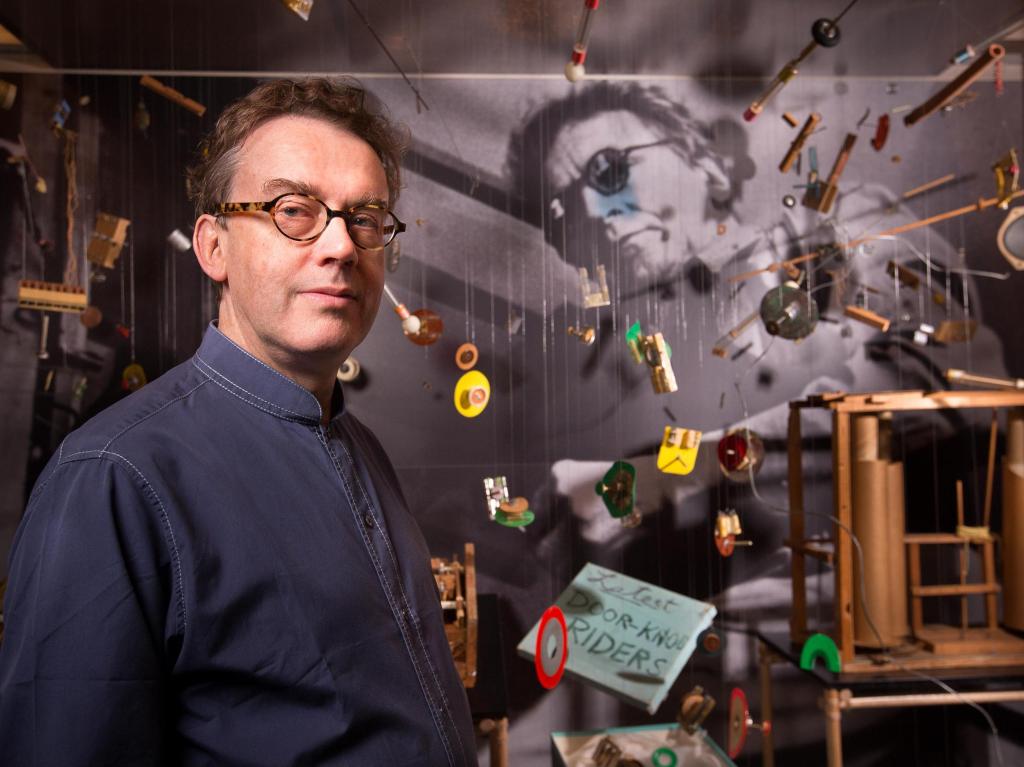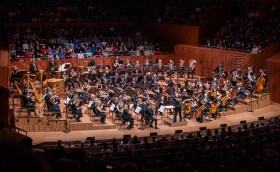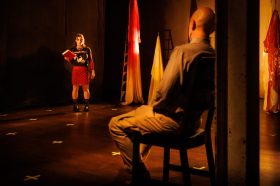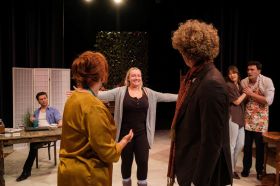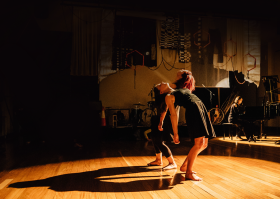Sir Jonathan Mills; Image credit: Peter Cassimento Photography.
In some cities, getting to grips with the works of a great artist – immersing yourself in their ideas and walking in their footsteps – can only be done at a remove. Not so in Melbourne, where instead of looking at artefacts online or in out of print books, admirers of pianist and composer Percy Grainger, and architects Walter Burley Griffin and Marian Mahony Griffin, can explore their works firsthand.
At the University of Melbourne, devotees of the Griffins can stand beneath the striking dome of the Newman College dining room and view the remarkable aesthetics which defines the pair’s signature architectural style.
The University is also home to the Grainger Museum, which holds within its walls some 100,000 artefacts – including music, instruments, manuscripts, artworks and costumes – documenting Grainger’s remarkable life.
Together, these two extraordinary buildings and all they represent have inspired Cultural Collisions, a major program presented by the University of Melbourne in conjunction with Melbourne Festival, curated by Sir Jonathan Mills and including a rare opportunity to hear one of Mills’ own compositions played live beneath the dome of Newman College.
A composer and eight-time Director of the Edinburgh Festival, Mills has devised and curated a campus-wide program of exhibitions, events and performances connecting the seemingly disparate works of Grainger and the Griffins.
‘The idea that the Griffins have an engagement with the University of Melbourne, or the idea that Percy Grainger might have a relationship with the University of Melbourne, is literally embodied in two amazing buildings – and you can go there and anyone can see it; you don’t have to imagine what that relationship is,’ he said.
Inspired by the University’s collections – ‘Its extraordinary archives, its extraordinary art collection, its extraordinary documents, its libraries’ – Mills began searching for a deeper connection between the Griffins and Grainger. He quickly found one.
‘I think there is a very powerful message that lurks beneath both Grainger and Walter Burley Griffin and Marian Mahoney; a very deep connection to that message that I would like to think is at the core of the values that we argue about and celebrate as being Australian for their egalitarian nature,’ he said.
As well as being a brilliant pianist, composer and arranger, Grainger was a visionary; a musical maverick whose passions could not be restrained to a single style or genre. A signature event of the Cultural Collisions program sees students from the Melbourne Conservatorium of Music (MCM) and the National Academy of Music (ANAM) join forces to pay tribute to Grainger’s restless musical spirit in a special series of five concerts featuring Grainger’s own compositions and arrangements, as well as newer works inspired by him
Learn more about the Cultural Collisions program.
‘He was a wonderful collector and arranger of folk traditions, of popular music, and he was fascinated by contemporary technology. And in thinking about contemporary technology and thinking about his own life as pianist, the hours spent alone practicing, he wanted to make music more available to more people. He wanted it to be free – free for all. To make everyone a musician,’ said Mills.
The end result of Grainger’s experiments were a collection of unusual instruments – music machines – designed to accessible to all. ‘‘They were precursors to the now very commonplace instruments like synthesisers that every rock and roll band anywhere you look has – what they call keyboards,’ said Mills.
‘As you can imagine these are very precious items in their original form, because they’re a unique archive of history and of the history of instrument-making, so they’re not available – they’re fragile. But by making replicas of them we are sharing, for the very first time with a new generation of people, the capacity to hear these weird and wonderful sounds that Percy was tinkering with and which lead on to the technological advancements in music later in the 20th century.’
Learn more about Percy Grainger’s Free Music Machines
A similar drive, to make the dream of home ownership achievable for ordinary Australians, also motivated the Griffins.
‘Walter was really excited about how he, as an architect and designer, could make it easier for people, for ordinary people to have the best ideas, the best designs, the best technology at their disposal to do with what they chose themselves. To equip people with the tools that they needed to have a really great home.’
In the Melbourne suburb of Eaglemont, the Griffins built themselves a new home, called Pholiota, using a revolutionary new system of brick-laying and brickwork called knitlock bricks – where the bricks literally knit together to form a strong wall.
‘It really is the case that using Walter’s system of knitlock brickwork with the machine that he would provide for you, on your property, you could actually go onto your land, borrow his machine, make your own bricks on site and hey presto build your own home … And what Walter and Marian were really looking to do was bring their skills as brilliant designers and really bringing the latest building technology to bear and making it available to everyone,’ Mills explained.
Mills has gone one step further for Cultural Collisions; finding not just inspiration in the Griffins’ architecture but music as well. As part of the program, his own composition Ethereal Eye will be performed in the dining room of Newman College, under the Griffins’ famous dome.
‘It will be challenging because we’re going to perform this piece in the dining hall at Newman College, and it’s not an auditorium, it’s not a purpose-built acoustic for musical composition or musical performance. But it’s perfect because it’s a building which was built by the Griffins and it evokes perfectly their spirit. It evokes absolutely brilliantly the idea of their attitudes to building and to space,’ he said.
‘And of course what we’re very keen to do is to suggest how architecture is not just a utilitarian function of providing shelter but is actually an idea of providing human dignity and a space in which the imagination can soar.’
Book tickets for Ethereal Eye at Newman College
Visitors to the Cultural Collisions will also be able to visit another of the Griffins’ building at the University of Melbourne thanks to a group of students who have rebuilt the Griffins’ Eaglemont home Pholiota on campus, ensuring that – like Grainger’s re-created music machines – visitors can see the egalitarian dream embodied.
‘So here we have a virtuoso pianist saying that music should be everyone, and we have the finest architects of their generation, Walter and Marian … and they’re saying the same thing; they’re saying “we are experts but we’re going to use our expertise not to enrich ourselves but to actually enrich the community.” And when you think about that in comparison to the conversations that we have to today – especially about housing – well, I think this an important message to share,’ said Mills.
‘I think it’s a very important conversation to have about the fundamental equality of our community, its values, and the opportunities it gives everyone, both cultural and physical. And I think the place to have this argument, this discussion, to show it to people tangibly but to have it in a way that is both fun, playful and exciting but also intellectually rigorous and scrupulous, is at a place like a university – all of those things coming together.’
The Cultural Collisions program runs from 6-23 October at the University of Melbourne’s Parkville campus. Visit events.unimelb.edu.au/cultural-collisions for full program details.
